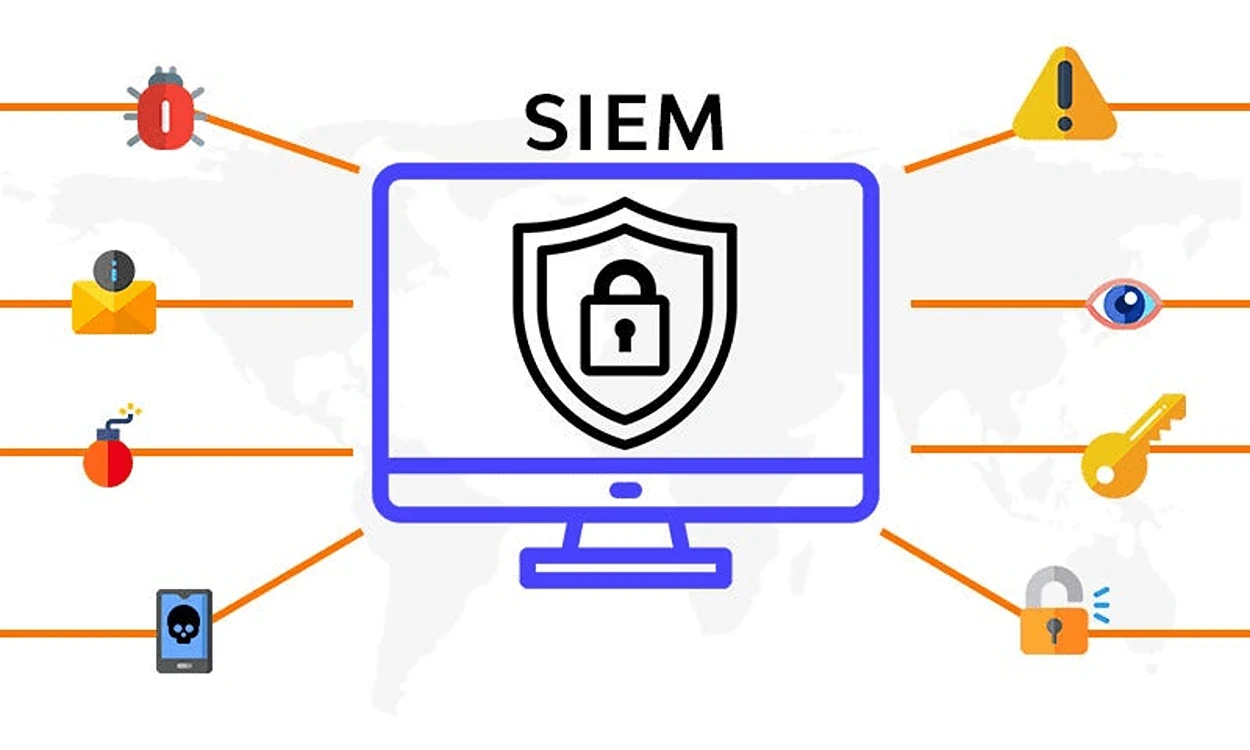What is SIEM?
SIEM stands for Security Information and Event Management, a centralized platform that combines two key functions:
- Security Information Management (SIM): Collecting and analyzing system logs from various devices and applications.
- Security Event Management (SEM): Monitoring security events in real-time, detecting threats, and enabling immediate response.
In other words, SIEM acts as the “analytical brain” of network security. It aggregates logs from firewalls, operating systems, business applications, and databases, then analyzes them to detect abnormal activity or potential cyberattacks.
It is now one of the most critical pillars of modern cybersecurity, especially for medium and large enterprises.
Why Do Organizations Need SIEM?
- Early Threat Detection: Identifies suspicious patterns that cannot be noticed manually.
- Real-Time Response: Provides instant alerts when a breach occurs.
- Compliance and Regulations: Ensures adherence to standards like PCI DSS, GDPR, HIPAA by storing and analyzing security logs.
- Holistic Visibility: Offers a centralized dashboard that displays everything happening within the network.
How Does SIEM Work in Practice?
- Log Collection: Gathers data from firewalls, IDS/IPS systems, application servers, email gateways, etc.
- Normalization: Converts raw logs into a unified format for easier analysis.
- Correlation: Connects different events to identify complex attacks (e.g., repeated failed logins + suspicious file upload attempts).
- Alerting: Generates notifications when unusual or malicious activity is detected.
- Reporting: Delivers detailed reports for management and audit purposes.
Leading SIEM Platforms
1. Splunk Enterprise Security
- Advantages: Advanced graphical interface, massive data analytics capabilities.
- Subscription: Licensed by daily data ingestion volume (GB/day).
- Deployment: Can be installed on-premises or used via Splunk Cloud.
- Ownership: SOC Analyst + SIEM Engineer.
2. IBM QRadar
- Advantages: Strong integration with IBM products, advanced threat detection algorithms.
- Subscription: Perpetual license or cloud subscription.
- Deployment: Ideal for large enterprises and government sectors.
- Ownership: Dedicated SOC team.
3. ArcSight (Micro Focus)
- Advantages: Highly powerful for organizations with complex infrastructures.
- Subscription: Based on devices and data volume.
- Deployment: Requires advanced technical expertise for configuration.
- Ownership: Senior SIEM Engineer.
4. Azure Sentinel (Microsoft Sentinel)
- Advantages: 100% cloud-native, seamless integration with Office 365 and Azure services.
- Subscription: Pay-as-you-go model based on usage.
- Deployment: Perfect for organizations operating fully on Microsoft Cloud.
- Ownership: Cloud Security Engineer or SOC Analyst.
5. ELK Stack + SIEM (Elastic Security)
- Advantages: Open-source, highly flexible, cost-efficient.
- Subscription: Free, with paid Elastic Cloud plans.
- Deployment: Suitable for startups and mid-sized companies.
- Ownership: DevSecOps Engineer or Cybersecurity Specialist experienced with ELK.
Key Roles & Responsibilities in SIEM Operations
- SOC Analyst (Security Operations Center Analyst):
- Monitors daily security events and alerts.
- Investigates security incidents.
- Skills: Log analysis, understanding attack tactics.
- Certifications: CompTIA Security+, CEH, GCIA.
- SIEM Engineer:
- Designs and configures SIEM systems.
- Builds correlation rules and detection use-cases.
- Skills: Scripting, database management, network protocols.
- Certifications: Splunk Certified Architect, IBM QRadar Certified Specialist.
- SOC Manager:
- Oversees SOC operations and teams.
- Defines incident response strategies.
- Certifications: CISSP, CISM.
Qualifications and Expertise Required for SIEM Specialists
- Strong technical background in networking and operating systems.
- Practical experience with SIEM tools and IDS/IPS systems.
- Analytical skills to detect patterns within log data.
- Relevant certifications:
- Splunk Core Certified Power User
- IBM QRadar SIEM Deployment (V7.3.2 or higher)
- GIAC Security Essentials (GSEC)
- CISSP (for management-level positions)
Conclusion
SIEM is no longer a luxury—it has become a necessity for any organization that handles sensitive data or operates under regulatory obligations. It is not just a tool but a complete ecosystem requiring:
- A suitable SIEM platform aligned with organizational size and needs.
- Skilled personnel (SOC Analysts, SIEM Engineers, SOC Managers).
- Well-defined policies for alert management and incident response.
Investing in SIEM means gaining clearer visibility, stronger security, and greater resilience against modern cyber threats.
 English
English
 العربية
العربية




Add New Comment